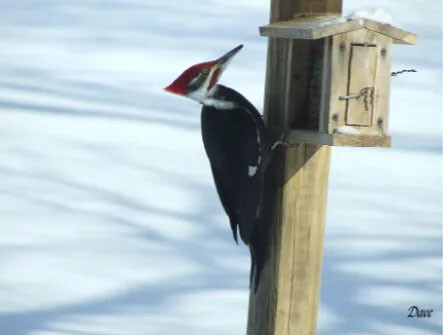Image

By Leslie R. Dye, MD, FWCPDOH
"There is something beautiful about walking on snow that nobody else has walked on. It makes you believe you’re special.”—Carol Rifka Brunt
 Pileated Woodpecker in Hisey Park, photo credit Dave Woehr
Pileated Woodpecker in Hisey Park, photo credit Dave WoehrI grew up on a farm and often had to feed the cows before I went to school in the winter. I remember dreading the cold in those days, but our house was not too far from the barn, so it was never a long process. Despite spending many of my younger years outside, I never really learned to dress appropriately for the cold. When I started hiking and backpacking with my late husband (a rock and ice climber), I learned how to stay warm and enjoy the outdoors in the winter. Initially, I was annoyed taking layers on and off, but soon realized these layers were the secret to comfort. My biggest fear is getting too hot when I am outside in the winter! I own coats that are too warm to wear anywhere, even in Antarctica (in the summer).
We are all told to watch the weather forecast and dress in layers, but often the details are missing. It is so important to prepare with coverage of every inch of skin. The appropriate clothing does not always need to be expensive, but the right fabric is important. Another option is using battery heated apparel.
When instructed to dress in layers, here are some basics:
A winter hat with or without a gaiter or face mask is a must. Fabric rules are the same. You can purchase wicking and wind resistant material in a hat and gloves. The beauty of hats and gloves is that they are a great way to regulate temperature quickly and easily. We lose more than 10% of our heat through an uncapped head. It is easy to remove or add an outer hat or gloves while hiking without stopping. The warmest headwear layers are a Balaklava covered with a hat and the hood of your jacket. You can slowly remove every layer, including the top of the Balaclava when you are warm.
Obviously, socks are also important, and layering can be done with socks. It is important to make sure the layers don’t rub against the skin and cause blisters and that footwear still fits when wearing different layers. Wear synthetic or wool socks over thin liner socks. Carrying an extra pair of socks, gloves and a hat is useful. An extra pair of socks can also be used as gloves in an emergency.
Choosing hiking boots would fill an entire blog, Make sure you have footwear that fits. When you buy a pair of hiking boots, find a store that will allow you to try them and return them if the fit is improper. Waterproof and insulated boots are available too.
Always protect your eyes from the sun and wind with goggles or sunglasses. Select the appropriate lenses for the weather. Just because it is cold doesn’t mean you can’t get sunburned. With snow on the ground, the sun rays reflect back to you. Sun -protective clothing is also available. Be sure to apply sunscreen and protect your eyes from the sun. Warmer packs can be placed in your gloves and/or boots, but sure they don’t affect the fit of your boots.
Remember that cold weather can kill batteries quickly. Lithium batteries hold up a little better than alkaline. Bring extra batteries and store all batteries and any battery powered items (cell phone, GPS, etc.) next to your body to keep them warm.
Remember to ask for help or search the topic when preparing to dress for cold weather. Specialty store employees are usually well trained in preparing for the outdoors and can help. When I started spending more time in the cold, I needed to purchase some new items, but my husband obtains much of his outerwear from thrift or big box stores. I still use items that are 30 years old for winter sports. Higher quality pieces will often last a long time, if cared for properly.
This is a list of 10 items many consider essential for hiking:
Many of the Warren County Parks offer great winter hiking. Some are also great for cross country skiing and snowshoeing. Try one of these when you are all dressed and ready to go: